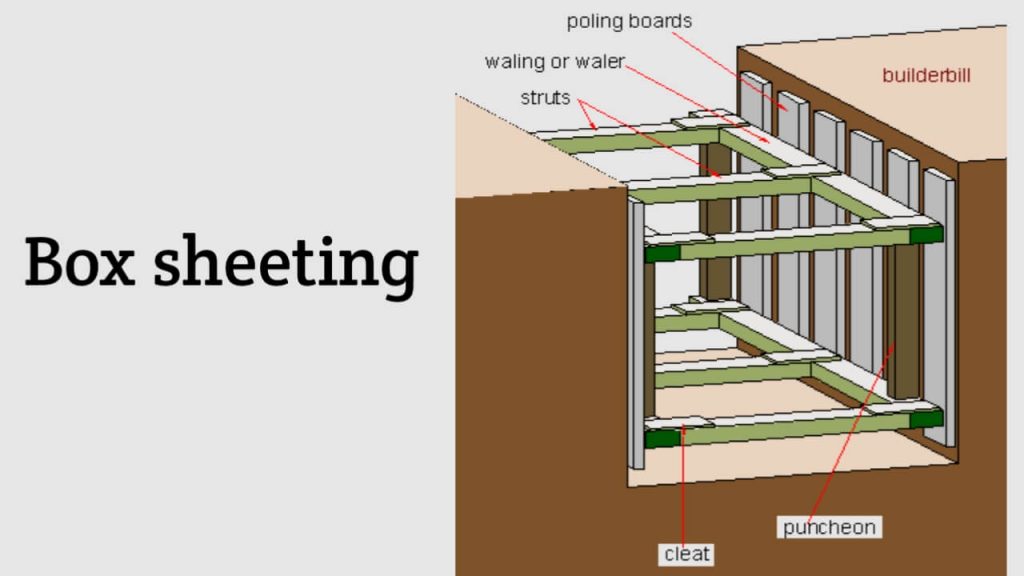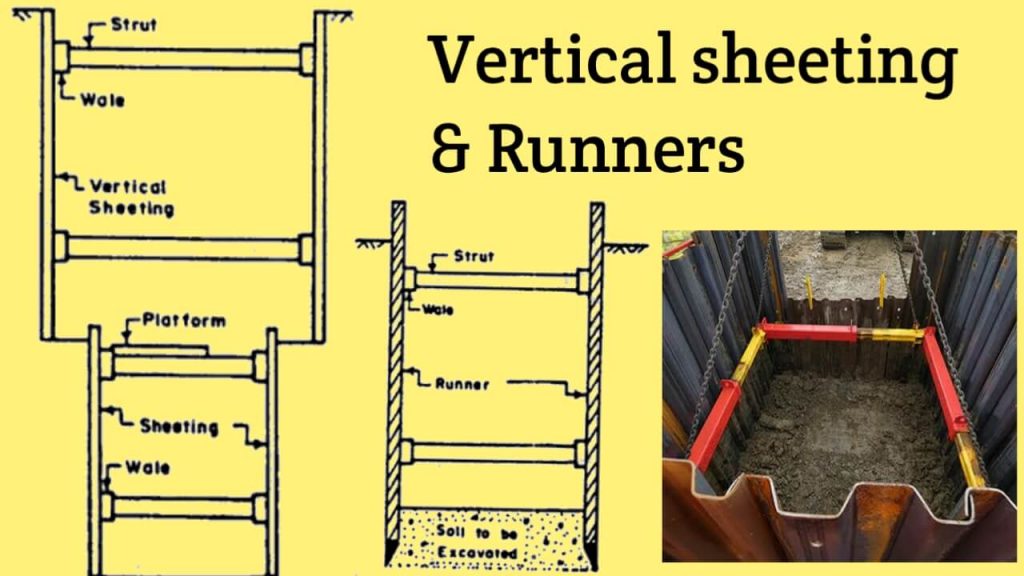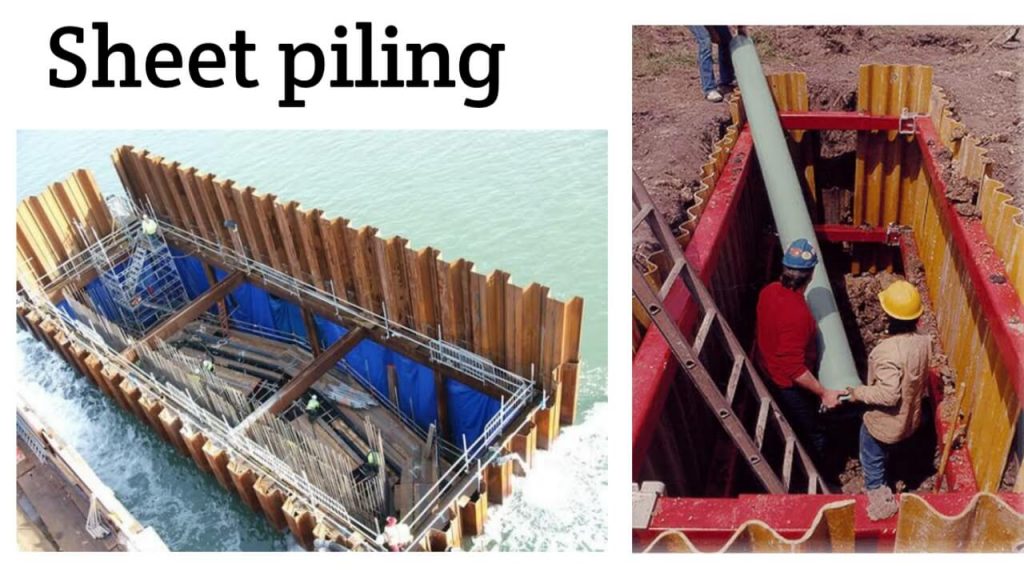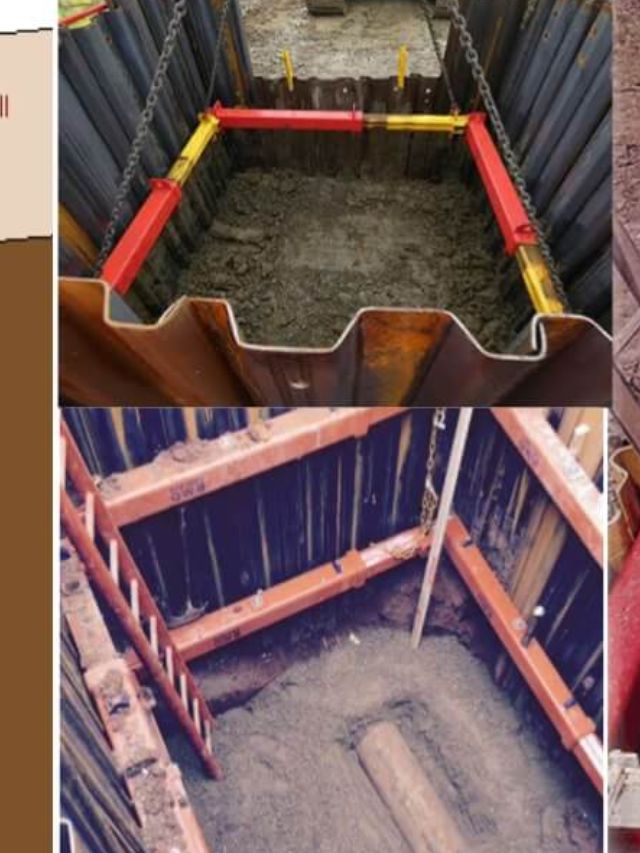In this web you get details of timbering. What is timbering, Meaning of timbering in construction, what are the member used in timbering, Necessity and importance of timbering, Methods of timbering, how to make timbering and shuttering in trench and what are the precaution taken during timbering and different types of shuttering work.
| Like us on Facebook | Click Here |
| Join our Telegram Group | Click Here |
| Subscribe us on YouTube | Click Here |
| Follow us on Google News | Click Here |
Table of Contents
What is timbering?
Timbering is a method to prevent trench side soil against collapse. During deep excavation, the sides of the trench collapse if the soil is not hard. The timbering prevents the side of the trenches against collapse.
Necessity or Importance of Timbering:
Here we explain why timbering of foundation trenches is necessary? What are the importance of timbering? And so more.
The requirement or importance of timbering is as follows:
- For the safety of excavation workers
- For the safety of the surrounding property
- For the safety of passersby and vehicles
- For the safety of public service property such as telephone cable, water pipes, electric cable.
Do You Know: 5 Best Structural Design and Analysis Software
Members Used in Timbering
A brief explanation of the technical terms associated with the study of timbering works is as under:
1. Polling Board:
A flat wooden plank which is in direct contact with the soil of the trench and is arranged in an vertical position on the side is called a polling board or planking.
2. Sheeting:
Sheeting is the process of holding a polling board or plank together or using a sheet instead of a plank.
3. Wales or walling:
The component attached to the trench wall, the sheeting to support the polling board, the component which is perpendicular to the polling board and parallel to the trench wall is called Wales or walling.
4. Strut:
A piece of wood used to support sheeting/walling with two walls of a trench and to maintain a certain distance between the Wales and the main line of the trench is called a Strut.
5. Bracing:
The diagonal straightening used between the walls to reinforce the timbering framework is called bracing.
6. Runners:
Trench walls are prone to collapse in very soft or hard soil. A special type of shoe made of iron should be placed at the bottom of the polling board used in such circumstances and 30 to 40 cm cm above the bottom surface during excavation, the planks are lowered to a greater depth with the help of shoe. These types of polling boards or sheets are called runners.
Also read: 5 Best Method To Repair Brick Wall Defects
Methods of Timbering:
There are five main methods for timbering:
- Stay Bracing
- Box Sheeting
- Vertical Sheeting
- Runners
- Sheet Piling
1. Stay Bracing Method:

- This type of timbering is used when soil is moderately firm and excavation depth is not more than 2 m.
- Polling boards are placed on the sides of the trench and it is kept in position with one or two Struts rows.
- These polling boards are placed at a distance of 3 to 4 m and are up to the full depth of the excavation.
- Width of excavation polling board – 250 mm
- Thickness of excavation polling board – 40 mm to 50 mm
Size of strut
– 100 mm x 100 mm (until trench depth is 2 m)
– 200 mm x 200 mm (when trench depth is more than 2 m)
Do You Know: Benefits of Google Earth for Civil Engineering
2. Box Sheeting Method:

- This type of timbering, Used when loose soil and depth of excavation not more than 4 m. It is a type of loose soil timbering.
- A box-like structure is made using sheeting, Wales, struts and bracing.
3. Vertical sheeting Method:

- This type of timbering is used when soil is loose and excavation depth is not more than 10 m.
- This method is similar to box sheeting.
- This type of timbering is also called double stage timbering.
- In each stage vertical sheet, horizontal Wales, strut and bracing are placed.
- Usually the offset is given at a 3 to 4 m of depth and its width is 30 cm to 60 cm.
- A platform is also made on the strut.
- This method is more suitable for arranging gutter pipes or water pipes in the ground at a greater depth.
Also Read: What is Shoring in Construction || Types || Full Explained
4. Runners Method:
This type of timbering is used when digging in very loose soil. Runners are long and thick wooden planks. Runners have a iron shoe attached to the bottom edge.
Runners are hammered into the ground to a depth of 30cm from the bottom of the trench. Runners are supported by Wales and struts.
5. Sheet piling Method:

Sheet piling is used in the following situations:
- When excavating over a large area.
- Excavating soil and its surrounding soil loose and soft.
- Water comes during excavation of soil.
- When Excavation depth is more than 10m.
- Greater width of trench.
There are two types of sheet piles:
1. Wooden sheet pile:
- Used to a depth of 10 m.
2. Steel sheet pile:
- Which is used up to a depth of 30 m. Steel sheet piles are used in different shapes and sizes.
Also Read: 7 Best Methods of Dewatering | Procedure | Necessity
Precautions to be taken during timbering:
Work during timbering the following precautions should be taken for the safety of the workers and the safety of the surrounding property:
1. Slip of Earth :
Soil erosion during deep excavation suppresses labour. Therefore special inspection should be done on the outside of the trench during such excavation. If cracks appear in the ground, the excavation should be stopped and the labours should be immediately instructed to move to a safe place.
Also Read: Essential Construction Safety Measures and Equipment
2. Testing of struts:
The struts should be kept in a fixed position and its rigidity should be checked periodically.
3. Sagging of Wales:
As the soil pressure on both sides of the trench increases, the Wales bend. Such Wales should be inspected from time to time and, if necessary, bent Wales should be prevented by giving more support or by placing strong planks.
4. Movement of timbering members:
Various timbering members like Sheeting, Wales, Struts, Bracing etc. move to their original position due to soil pressure and timbering is weakened.
Timbering work should therefore be inspected frequently and any defects found should be repaired immediately. Such observation is especially necessary during the rainy season.
5. Removal of Timbering:
Timber boards, supports, Wales, etc. Should be removed safely in stages after completion of work.
The soil filling in the trench should be done by leaving enough water in layers of 20 cm to 30 cm thickness so that the soil layer does not settle.
Also Read: Different Types of Pile Foundation Used in Construction
6. Safety helmets:
If stones, pieces of wood or other materials are likely to fall during excavation in the trench, safety helmets should be provided for the workers to wear on their heads.
7. Ladders:
Ladders should be arranged at certain distances in the trench so that the labour can escape from the trench safely in case of an accident. When digging in hard soils, ladders should be arranged at a distance of 30 m and in loose soils at a distance of 15 m.
8. Traffic control:
The movement of trucks, wagons, other machinery from the edge of the trench should be done under the guidance of an experienced supervisor.
9. Tools:
Workers should be provided with proper tools. So that they can use such equipment during emergencies and come out of the trench safely.
Also Read: GFRP Bars vs Steel Bars
10. Supervisors:
Supervisors should be appointed to supervise the labourers working in the trenches. The labours alone should not be allowed to go into the trench.
11. Protection of adjacent properties:
If the foundations of the surrounding building become unsafe due to excavation, such building is to be protected by temporary support.
12. Shelter:
A suitable resting place should be arranged near the trench so that the labours can take their food and rest. Workers should be forbidden to rest in the trenches.
13. Fencing and lights around the trench:
Wire fencing should be made around the trench to prevent pedestrians, vehicles or animals from falling into the trench. Red lights should be kept at the edge of the trench at night to prevent accidents.
14. Design and Arrangements of Timbering members:
The size of the member should be determined on the basis of calculating the load on the various members used in timbering such as planks, struts, etc. The spacing and size of such members are determined to keep in view the type of soil and depth of the trench.
Difference Between Timbering and Shoring
| Timbering | Shoring |
|---|---|
| Timbering is a support system that is generally used to support trenches or pits. | Shoring is a support system that is used to support wall, long excavated sides, to support structural system of building, etc. |
| Timbering is required for safety of excavation workers, surrounding property, pedestrian or vehicle, public service, etc. | Shoring is required for support of slender members, defective walls, roofs, compound walls, floors, etc. |
| Types of timbering of trenches : Stay Bracing Box Sheeting Vertical Sheeting Runners Sheet Piling | Types of shoring: Raking shores or Inclined shores Flying shores or Horizontal shores Dead shores or vertical shores |
Methods of Timbering Quick Details Stories
Frequently Asked Questions
What is Timbering in Construction?
Timbering is defined as a type of method which is used to prevent the trench side soil against collapse.
Why Timbering is important?
Timbering is important to prevent the trench side soil against collapse. it is important for safety of excavation workers, surrounding property, safety of pedestrian, vehicle whose are walking near the trench, for the safety of public service property such as water pipes, electric cables, etc.
What are the types or methods of Timbering?
1. Stay Bracing
2. Box Sheeting
3. Vertical Sheeting
4. Runners
5. Sheet pilingWhat is the difference between timbering and shoring?
Timbering and Shoring, both are support systems, used for the same purpose to prevent side soil from collapse, But the methodology and situation are different for both.
Timbering is used for less height of trenches like in the case of foundations trench.
But the Shoring is used for more height of trenches like it is used to support the trench of walls, etc.
Sometimes, Timbering is also called as a shoring system consisting of timber planks when the height is more.
Which height did we need to support the side of trenches by timbering methods?
There are no criteria for timbering is required in the excavation of more than this height. you can use it for 1m height 2m height, and 3m height.
simply I say you that, it is depends on your soil condition
In Box Sheeting Timbering the members supporting to all sitting together is called as?
Inbox sheeting timbering the members supporting to all sitting together is called as Struts and waling.
Which type of timbering system is adopted for deep trenches up to 10m depth in the soft ground?
Vertical sheeting or sheet piling type of timbering system is adopted for deep trenches up to 10m depth in soft ground.
When stay bracing type of timbering is used?
Stay bracing type of timbering is used when the depth of excavation is not more than 2m.
What is the main purpose of timbering of foundation trenches?
The main purpose of timbering of foundation trenches is to prevent side soil of trenches against collapse.
What is strut in timbering?
The horizontal member supporting to timber board in timbering is called as strut.
Box sheeting timbering method is adopted in which type of soil conditions?
Box sheeting timbering method is adopted in Loose soil conditions and when the height of excavation is not more than 4m.
What is Timbering | Importance of Timbering | Methods of Timbering of trenches PDF Download
Also read:
- What is Under reamed piles || construction procedure || Advantages and Disadvantages.
- What is Ferro cement? Material, Construction Method, Application, Uses.

I am a Professional Civil & Structural Engineer having more than 4 years of experience in Engineering, Procurement and Construction industry. Here i sharing the latest updates of EPC Projects and Construction News.



